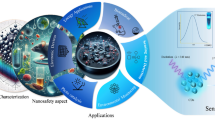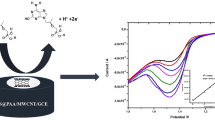Abstract
It was found that multi-walled carbon nanotubes (MWNTs) could catalyze the redox reaction between chlorauric acid (HAuCl4) and reductive drugs such as tetracycline hydrochloride (TC), producing gold nanoparticles (Au NPs). By measuring the plasmon resonance light scattering (PRLS) signals of the resulting Au NPs, tetracycline hydrochloride can be detected simply and rapidly with a linear range of 4–26 μmol/L, a correlated coefficient (r) of 0.9955, and a limit of detection (3σ) of 6.0 nmol/L. This method has been successfully applied to the detection of tetracycline hydrochloride tablets in clinic with the recovery of 101.9% and that of fresh urine samples with the recovery of 98.3%–102.0%.
Similar content being viewed by others
References
Lijima S. Helical microtubules of graphitic carbon. Nature, 1991, 354(6348): 56–58
Zhang M, Mullens C, Gorski W. Coimmobilization of dehydrogenases and their cofactors in electrochemical biosensors. Anal Chem, 2007, 79(6): 2446–2450
Wang J, Liu G, Jan M R. Ultrasensitive electrical biosensing of proteins and DNA: Carbon-nanotube derived amplification of the recognition and transduction events. J Am Chem Soc, 2004, 126(10): 3010–3011
Wu W, Wieckowski S, Pastorin G, Benincasa M, Klumpp C, Briand J P, Gennaro R, Prato M, Bianco A. Targeted delivery of amphotericin B to cells by using functionalized carbon nanotubes. Angew Chem Int Ed, 2005, 44(39): 6358–6362
Wang Z H, Liang Q L, Wang Y M, Luo G A. Carbon nanotube-in-tercalated graphite electrodes for simultaneous determination of dopamine and serotonin in the presence of ascorbic acid. J Electroanal Chem, 2003, 540: 129–134
Arribas A S, Bermejo E, Chicharro M, Zapardiel A, Luque G L, Ferreyra N F, Rivas G A. Analytical applications of glassy carbon electrodes modified with multi-wall carbon nanotubes dispersed in poly-ethylenimine as detectors in flow systems. Anal Chim Acta, 2007, 596(2): 183–194
Lin Y, Lu F, Tu Y, Ren Z. Glucose biosensors based on carbon nanotube nanoelectrode ensembles. Nano Lett, 2004, 4(2): 191–195
Zhang M, Mullens C, Gorski W. Insulin oxidation and determination at carbon electrodes. Anal Chem, 2005, 77(19): 6396–6401
Zhang M, Gorski W. Electrochemical sensing based on redox mediation at carbon nanotubes. Anal Chem, 2005, 77(13): 3960–3965
Zhang M, Gorski W. Electrochemical sensing platform based on the carbon nanotubes/redox mediators-biopolymer system. J Am Chem Soc, 2005, 127(7): 2058–2059
Yu X, Munge B, Patel V, Jensen G, Bhirde A, Gong J D, Kim S N, Gillespie J, Gutkind J S, Papadimitrakopoulos F, Rusling J F. Carbon nanotube amplification strategies for highly sensitive immunodetection of cancer biomarkers. J Am Chem Soc, 2006, 128(34): 11199–11205
Du B A, Li Z P, Liu C H. One-step homogeneous detection of DNA hybridization with gold nanoparticle probes by using a linear light-scattering technique. Angew Chem Int Ed, 2006, 45(1): 1–5
Li H, Rothberg L. Colorimetric detection of DNA sequences based on electrostatic interactions with unmodified gold nanoparticles. PNAS, 2004, 101(39): 14036–14039
Thanh N T K, Rosenzweig Z. Development of an aggregation-based immunoassay for anti-protein a using gold nanoparticles. Anal Chem, 2002, 74(7): 1624–1628
Ao L, Gao F, Pan B, He R, Cui D. Fluoroimmunoassay for antigen based on fluorescence quenching signal of gold nanoparticles. Anal Chem, 2006, 78(4): 1104–1106
Shen X W, Huang C Z, Li Y F. Localized surface plasmon resonance sensing detection of glucose in the serum samples of diabetes sufferers based on the redox reaction of chlorauric acid. Talanta, 2007, 72(4): 1432–1437
Baron R, Zayats M, Willner I. Dopamine-, L-DOPA-, adrenaline-, and noradrenaline-induced growth of Au nanoparticles: Assays for the detection of neurotransmitters and of tyrosinase activity. Anal Chem, 2005, 77(6): 1566–1571
Aslan K, Holley P, Davies L, Lakowicz J R, Geddes C D. Angular-ratiometric plasmon-resonance based light scattering for bioaffinity sensing. J Am Chem Soc, 2005, 127(34): 12005–12121
Wu L P, Li Y F, Huang C Z, Zhang Q. Visual detection of Sudan dyes based on the plasmon resonance light scattering signals of silver nanoparticles. Anal Chem, 2006, 78(15): 5570–5577
Liu S P, Yang Z, Liu Z F, Liu J T, Shi Y. Resonance Rayleigh scattering study on the interaction of gold nanoparticles with berberine hydrochloride and its analytical application. Anal Chim Acta, 2006, 572: 283–289
Yang T, Wang L J, Zhao J, Huangfu W G. Detection of tetracyclines residues in aquatic product by HPLC. Chem Anal Meter (in Chinese), 2007, 16(2): 35–36
Pei C J, Zhang Z J, Liu W. Determination of tetracycline in fish and shrimp by chemiluminescence micro-flow injection on a chip. J Instru Anal (in Chinese), 2006, 25(3): 83–85
Liu Y H, Zhang C P, Men L Q, Liu Z Z, Wang S H. Determination of tetracycline antibiotics residues in chicken muscle by liquid chromatography-tandem mass spectrometry. Chinese J Chromat (in Chinese), 2006, 24(3): 171–173
Xing X P. Trace determination of tetracyclines in eggs by capillary electrophoresis with electrochemical detection. J Yancheng Inst Tech Natur Sci Ed (in Chinese), 2006, 19(4): 16–19
Wang X, Liu H, Jin Y, Chen C. Polymer-functionalized multiwalled carbon nanotubes as lithium intercalation hosts. J Phys Chem B, 2006, 110(21): 10236–10240
He P, Bayachou Me. Layer-by-layer fabrication and characterization of DNA-wrapped single-walled carbon nanotube particles. Langmuir, 2005, 21(13): 6086–6092
Cai C X, Chen J. Direct electron transfer of redox proteins and enzymes promoted by carbon nanotubes. Electrochemistry (in Chinese), 2004, 10(2): 159–167
Wang L, Yang Q, Yuan Z B. Electrochemical behavior of L-3,4-dihydroxyphenylalanine at the SWNT-modified electrode. Anal Lab (in Chinese), 2004, 23(6): 13–15
Zheng M, Rostovtsev V V. Photoinduced charge transfer mediated by DNA-wrapped carbon nanotubes. J Am Chem Soc, 2006, 128(24): 7702–7703
Zheng M, Diner B A. Solution redox chemistry of carbon nanotubes. J Am Chem Soc, 2004, 126(47): 15490–15494
Author information
Authors and Affiliations
Corresponding author
Additional information
Supported by the National Natural Science Foundation of China (Grant No. 20675065, 20425517) and the National Research Foundation for the Doctoral Program of Higher Education of China (Grant No. JYB20060635003)
Rights and permissions
About this article
Cite this article
Hu, P., Huang, C. & Zhang, L. Multi-walled carbon nanotubes based catalyst plasmon resonance light scattering analysis of tetracycline hydrochloride. Sci. China Ser. B-Chem. 51, 866–871 (2008). https://doi.org/10.1007/s11426-008-0090-8
Received:
Accepted:
Published:
Issue Date:
DOI: https://doi.org/10.1007/s11426-008-0090-8




